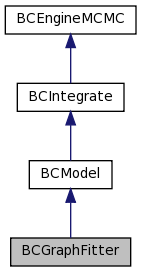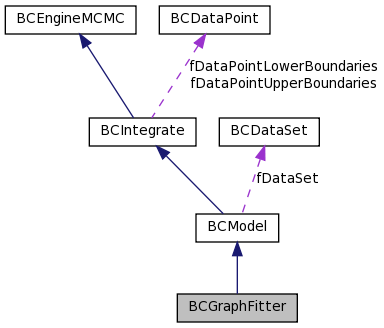A class for fitting graphs with functions. More...
#include <BCGraphFitter.h>


Public Member Functions | |
Constructors and destructors | |
| BCGraphFitter () | |
| BCGraphFitter (TGraphErrors *graph, TF1 *func) | |
| ~BCGraphFitter () | |
Member functions (get) | |
| TGraphErrors * | GetGraph () |
| TF1 * | GetFitFunction () |
| TGraph * | GetErrorBand () |
| TGraph * | GetGraphFitFunction () |
Member functions (set) | |
| int | SetGraph (TGraphErrors *graph) |
| int | SetFitFunction (TF1 *func) |
Member functions (miscellaneous methods) | |
| double | LogAPrioriProbability (std::vector< double > parameters) |
| double | LogLikelihood (std::vector< double > parameters) |
| double | FitFunction (std::vector< double > x, std::vector< double > parameters) |
| int | Fit () |
| int | Fit (TGraphErrors *graph, TF1 *func) |
| void | DrawFit (const char *options="", bool flaglegend=false) |
| virtual double | CDF (const std::vector< double > ¶meters, int index, bool lower=false) |
Private Attributes | |
| TGraph * | fErrorBand |
| TF1 * | fFitFunction |
| TGraphErrors * | fGraph |
| TGraph * | fGraphFitFunction |
Detailed Description
A class for fitting graphs with functions.
- Version:
- 1.0
- Date:
- 2008 This class allows fitting of a TGraphErrors using a TF1 function. It doeasn't take the x uncertainties into account. For that look at BCGraphXFitter (not yet implemented).
Definition at line 34 of file BCGraphFitter.h.
Constructor & Destructor Documentation
| BCGraphFitter::BCGraphFitter | ( | ) |
Default constructor
Definition at line 26 of file BCGraphFitter.cxx.
: BCModel("GraphFitter") { fGraph = 0; fFitFunction = 0; fErrorBand = 0; fGraphFitFunction = 0; this -> MCMCSetNIterationsRun(2000); this -> SetFillErrorBand(); }
| BCGraphFitter::BCGraphFitter | ( | TGraphErrors * | graph, | |
| TF1 * | func | |||
| ) |
Constructor
- Parameters:
-
graph pointer to TGraphErrors func pointer to TF1
Definition at line 40 of file BCGraphFitter.cxx.
: BCModel("GraphFitter") { fGraph = 0; fFitFunction = 0; fErrorBand = 0; fGraphFitFunction = 0; this -> MCMCSetNIterationsRun(2000); this -> SetGraph(graph); this -> SetFitFunction(func); this -> SetFillErrorBand(); }
| BCGraphFitter::~BCGraphFitter | ( | ) |
Member Function Documentation
| double BCGraphFitter::CDF | ( | const std::vector< double > & | , | |
| int | , | |||
| bool | = false | |||
| ) | [virtual] |
1dim cumulative distribution function of the probability to get the data f(x_i|param) for a single measurement, assumed to be of identical functional form for all measurements
- Parameters:
-
parameters The parameter values at which point to compute the cdf index The data point index starting at 0,1...N-1 lower only needed for discrete distributions! Return the CDF for the count one less than actually observed, e.g. in Poisson process, if 3 actually observed, then CDF(2) is returned
Reimplemented from BCModel.
Definition at line 329 of file BCGraphFitter.cxx.
{
//format: x y error_x error_y
std::vector<double> values = fDataSet->GetDataPoint(index)->GetValues();
if (values.at(2))
BCLog::OutWarning("BCGraphFitter::CDF: Non-zero errors in x-direction are ignored!");
// get the observed value
double yObs = values.at(1);
// expectation value
double yExp = FitFunction(values, parameters);
return ROOT::Math::normal_cdf(yObs, values.at(3), yExp);
}
| void BCGraphFitter::DrawFit | ( | const char * | options = "", |
|
| bool | flaglegend = false | |||
| ) |
Draw the fit in the current pad.
Definition at line 278 of file BCGraphFitter.cxx.
{
if (!fGraph)
{
BCLog::Out(BCLog::error, BCLog::error,"BCGraphFitter::DrawFit() : TGraphErrors not defined.");
return;
}
if (!fFitFunction)
{
BCLog::Out(BCLog::error, BCLog::error,"BCGraphFitter::DrawFit() : Fit function not defined.");
return;
}
// check wheather options contain "same"
TString opt = options;
opt.ToLower();
// if not same, draw the histogram first to get the axes
if(!opt.Contains("same"))
fGraph -> Draw("ap");
// draw the error band as central 68% probability interval
fErrorBand = this -> GetErrorBandGraph(0.16, 0.84);
fErrorBand -> Draw("f same");
// draw the fit function on top
fGraphFitFunction = this -> GetFitFunctionGraph( this->GetBestFitParameters() );
fGraphFitFunction -> SetLineColor(kRed);
fGraphFitFunction -> SetLineWidth(2);
fGraphFitFunction -> Draw("l same");
// now draw the histogram again since it was covered by the band and
// the best fit
fGraph -> Draw("p same");
// draw legend
if (flaglegend)
{
TLegend * legend = new TLegend(0.25, 0.75, 0.55, 0.95);
legend -> SetBorderSize(0);
legend -> SetFillColor(kWhite);
legend -> AddEntry(fGraph, "Data", "P");
legend -> AddEntry(fGraphFitFunction, "Best fit", "L");
legend -> AddEntry(fErrorBand, "Error band", "F");
legend -> Draw();
}
gPad -> RedrawAxis();
}
| int BCGraphFitter::Fit | ( | TGraphErrors * | graph, | |
| TF1 * | func | |||
| ) |
Performs the fit of the graph with the function.
- Parameters:
-
graph pointer to TGraphErrors object func pointer to TF1 object
- Returns:
- An error code.
Definition at line 236 of file BCGraphFitter.cxx.
{
// set graph
if (!this -> SetGraph(graph))
return 0;
// set function
if (!this -> SetFitFunction(func))
return 0;
// check setup
BCLog::Out(BCLog::detail,BCLog::detail,
Form("Fitting %d data points with function of %d parameters",GetNDataPoints(),GetNParameters()));
if(GetNDataPoints() <= (int)GetNParameters())
{
BCLog::Out(BCLog::warning,BCLog::warning,
Form("Number of parameters (%d) lower than or equal to number of points (%d)."
, GetNParameters(), GetNDataPoints()));
BCLog::Out(BCLog::warning,BCLog::warning,"Fit doesn't have much meaning.");
}
// perform marginalization
this -> MarginalizeAll();
// maximize posterior probability, using the best-fit values close
// to the global maximum from the MCMC
this -> FindModeMinuit( this -> GetBestFitParameters(), -1);
// calculate p-value from the chi2 probability
// this is only valid for a product of gaussiang which is the case for
// the BCGraphFitter
this -> GetPvalueFromChi2(this -> GetBestFitParameters(), 3);
this -> GetPvalueFromChi2NDoF(this -> GetBestFitParameters(), 3);
// print summary to screen
this -> PrintShortFitSummary(1);
return 1;
}
| int BCGraphFitter::Fit | ( | ) | [inline] |
Performs the fit. The graph and the function has to beset beforehand.
- Returns:
- An error code.
Definition at line 117 of file BCGraphFitter.h.
{ return this -> Fit(fGraph, fFitFunction); };
| double BCGraphFitter::FitFunction | ( | std::vector< double > | x, | |
| std::vector< double > | parameters | |||
| ) | [virtual] |
Returns the value of the 1D fit function for a given set of parameters at a given x.
- Parameters:
-
x point to calculate the function value at parameters parameters of the function
Reimplemented from BCIntegrate.
Definition at line 226 of file BCGraphFitter.cxx.
{
// set the parameters of the function
fFitFunction -> SetParameters(¶ms[0]);
return fFitFunction -> Eval(x[0]);
}
| TGraph* BCGraphFitter::GetErrorBand | ( | ) | [inline] |
- Returns:
- pointer to the error band
Definition at line 72 of file BCGraphFitter.h.
{ return fErrorBand; };
| TF1* BCGraphFitter::GetFitFunction | ( | ) | [inline] |
| TGraphErrors* BCGraphFitter::GetGraph | ( | ) | [inline] |
| TGraph* BCGraphFitter::GetGraphFitFunction | ( | ) | [inline] |
- Returns:
- pointer to a graph for the fit function
Definition at line 77 of file BCGraphFitter.h.
{ return fGraphFitFunction; };
| double BCGraphFitter::LogAPrioriProbability | ( | std::vector< double > | parameters | ) | [virtual] |
The log of the prior probability. It is set to be flat in all parameters.
- Parameters:
-
parameters vector containing the parameter values
Reimplemented from BCModel.
Definition at line 180 of file BCGraphFitter.cxx.
{
// using flat probability in all parameters
double logprob = 0.;
for(unsigned int i=0; i < this -> GetNParameters(); i++)
logprob -= log(this -> GetParameter(i) -> GetRangeWidth());
return logprob;
}
| double BCGraphFitter::LogLikelihood | ( | std::vector< double > | parameters | ) | [virtual] |
The log of the conditional probability.
- Parameters:
-
parameters vector containing the parameter values
Reimplemented from BCModel.
Definition at line 192 of file BCGraphFitter.cxx.
{
// initialize probability
double logl = 0.;
// set the parameters of the function
// passing the pointer to first element of the vector is
// not completely safe as there might be an implementation where
// the vector elements are not stored consecutively in memory.
// however it is much faster than copying the contents, especially
// for large number of parameters
fFitFunction -> SetParameters(¶ms[0]);
// loop over all data points
for (int i = 0; i < this -> GetNDataPoints(); i++)
{
std::vector <double> x = GetDataPoint(i) -> GetValues();
// her we ignore the errors on x even when they're available
// i.e. we treat them just as the region specifiers
double y = x[1];
double yerr = x[3];
double yexp = this -> FitFunction(x,params);
// calculate log of probability assuming
// a Gaussian distribution for each point
logl += BCMath::LogGaus(y, yexp, yerr, true);
}
return logl;
}
| int BCGraphFitter::SetFitFunction | ( | TF1 * | func | ) |
- Parameters:
-
func pointer to TF1 object
Definition at line 135 of file BCGraphFitter.cxx.
{
if(!func)
{
BCLog::Out(BCLog::error,BCLog::error,"BCGraphFitter::SetFitFunction() : TF1 not created.");
return 0;
}
// get the new number of parameters
int npar = func -> GetNpar();
if(!npar)
{
BCLog::Out(BCLog::error,BCLog::error,"BCGraphFitter::SetFitFunction() : TF1 has zero parameters. Not able to fit.");
return 0;
}
// set the function
fFitFunction = func;
// update the model name to contain the function name
this -> SetName(TString::Format("GraphFitter with %s",fFitFunction->GetName()));
// reset parameters
fParameterSet -> clear();
// add parameters
for (int i = 0; i < npar; ++i)
{
double xmin;
double xmax;
fFitFunction -> GetParLimits(i, xmin, xmax);
this -> AddParameter(fFitFunction->GetParName(i), xmin, xmax);
}
return this -> GetNParameters();
}
| int BCGraphFitter::SetGraph | ( | TGraphErrors * | graph | ) |
- Parameters:
-
graph pointer to TGraphErrors object
Definition at line 57 of file BCGraphFitter.cxx.
{
if(!graph)
{
BCLog::Out(BCLog::error,BCLog::error,"BCGraphFitter::SetGraph() : TGraphErrors not created.");
return 0;
}
int npoints = graph -> GetN();
if(!npoints)
{
BCLog::Out(BCLog::error,BCLog::error,"BCGraphFitter::SetGraph() : TGraphErrors is empty.");
return 0;
}
else if(npoints==1)
{
BCLog::Out(BCLog::error,BCLog::error,"BCGraphFitter::SetGraph() : TGraphErrors has only one point. Not able to fit.");
return 0;
}
fGraph = graph;
double * x = fGraph -> GetX();
double * y = fGraph -> GetY();
double * ex = fGraph -> GetEX();
double * ey = fGraph -> GetEY();
if(!ey)
{
BCLog::Out(BCLog::error,BCLog::error,"BCGraphFitter::SetGraph() : TGraphErrors has NO errors set on Y. Not able to fit.");
return 0;
}
BCDataSet * ds = new BCDataSet();
// fill the dataset
// find x and y boundaries for the error band calculation
double xmin=x[0];
double xmax=x[0];
double ymin=y[0];
double ymax=y[0];
for (int i = 0; i < npoints; ++i)
{
// if x errors are not set, set them to zero
double errx = ex ? ex[i] : 0.;
// create the data point
BCDataPoint * dp = new BCDataPoint(4);
dp -> SetValue(0, x[i]);
dp -> SetValue(1, y[i]);
dp -> SetValue(2, errx);
dp -> SetValue(3, ey[i]);
ds -> AddDataPoint(dp);
if(x[i]-errx < xmin)
xmin = x[i]-errx;
else if(x[i]+errx > xmax)
xmax = x[i]+errx;
if(y[i] - 5.*ey[i] < ymin)
ymin = y[i] - 5.*ey[i];
else if(y[i] + 5.*ey[i] > ymax)
ymax = y[i] + 5.*ey[i];
}
this -> SetDataSet(ds);
// set boundaries for the error band calculation
this -> SetDataBoundaries(0, xmin, xmax);
this -> SetDataBoundaries(1, ymin, ymax);
this -> SetFitFunctionIndices(0, 1);
return this -> GetNDataPoints();
}
Member Data Documentation
TGraph* BCGraphFitter::fErrorBand [private] |
Pointer to the error band (for legend)
Definition at line 147 of file BCGraphFitter.h.
TF1* BCGraphFitter::fFitFunction [private] |
The fit function
Definition at line 143 of file BCGraphFitter.h.
TGraphErrors* BCGraphFitter::fGraph [private] |
The graph containing the data.
Definition at line 139 of file BCGraphFitter.h.
TGraph* BCGraphFitter::fGraphFitFunction [private] |
Pointer to a graph for displaying the fit function
Definition at line 151 of file BCGraphFitter.h.
The documentation for this class was generated from the following files:
 1.7.1
1.7.1